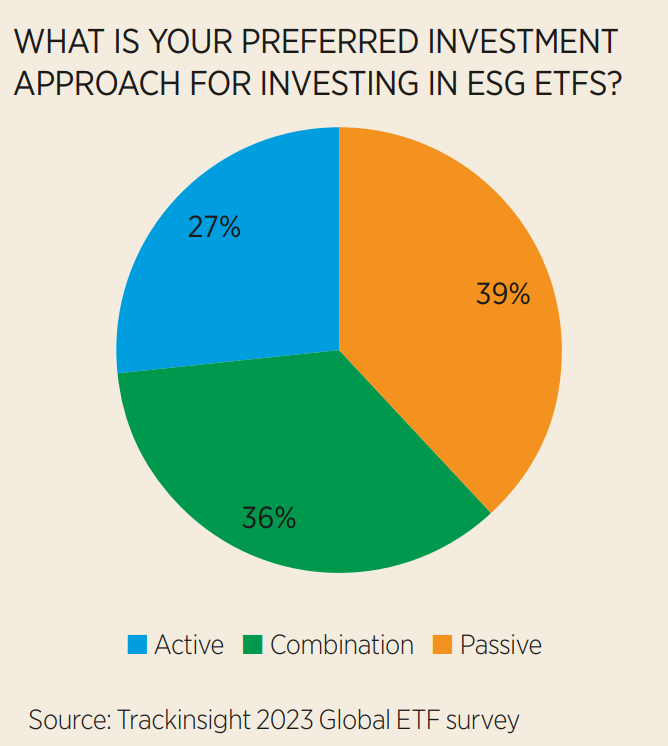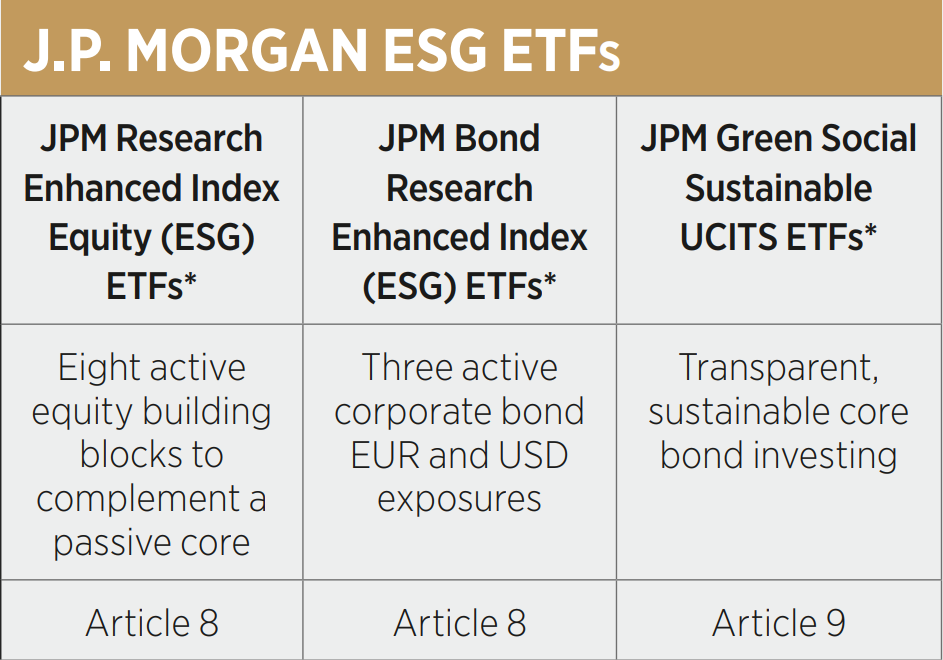This is a marketing communication. Please refer to the prospectus and the KID or KIID before making any final investment decisions.
The momentum in ETF flows has continued to be eye-catching. By the end of 2022, the global ETF space had reached $11trn assets under management (AUM). If it continues to grow at the current pace, assets are set to double by 2027, with several major drivers behind this including continued client adoption, accelerating demand for active ETFs and a bigger focus on fixed income.
The 2023 Trackinsight Global ETF survey shows that the share of ETF buyers who do not allocate to active ETFs has decreased year-on-year from over 45% in 2021 to just over 30% in 2023.

We have also seen a recent acceleration of active ETF flows. In the US, 33% of flows went into active ETFs in Q1 and in the UCITS space it was 6%, according to Bloomberg, as at 31 March.
Evolution of the active ETF market
This momentum is only likely to continue, according to several other recently published surveys. According to the Brown Brothers Harriman (BBH) 2023 Global ETF Investor Survey, 32% of European investors plan to increase their allocation to active ETFs this year. This is also echoed by the PwC survey “ETFs 2027: A world of new possibilities” which states that 30% of ETF buyers in Europe expect significant demand for active ETFs in the next two to three years.
Tremendous innovation has occurred in the active ETF market in recent years. There are now 18 ETF issuers who offer active UCITS ETFs with over 70 ETFs available to invest in, according to ETFbook, as at 31 March. Fixed income remains the biggest asset class for active ETF allocations, with 47% of active UCITS ETF assets aligned to fixed income strategies. The active ETF market is already as diverse as the active mutual fund market, ranging from index-like active research-enhanced indexing strategies, to higher tracking error, unconstrained or even thematic strategies.

With more active ETF providers entering the market, potential ETF buyers’ concerns regarding a limited product range should decrease over time.
In terms of trading volume, ETFs currently account for 15% of European equity activity with an annual turnover of €3trn. Today, client dealing desks have several options to execute their ETF flow. Under the trading lifecycle of an ETF can help clients deliver better outcomes.
European ETF secondary market liquidity is not limited to shares trading on a particular stock exchange listing. ETF liquidity providers can trade across multiple venues (both on- and off-exchange) as well as create new shares in the primary market to balance ETF supply and demand.
There is also growing industry recognition about the benefits of a consolidated tape alongside further technological advances in ETF fair value algorithms. Taken together, these two developments should facilitate higher market trading volumes and improved execution outcomes for clients. This holds true whether an ETF is active or passive.
ESG investing and active ETFs
In 2022, 60% of net flows into UCITS ETFs went into ESG strategies. ESG investing will continue to be one of the major drivers in ETF allocations according to Trackinsight. Its 2023 survey highlighted 30% of ETF buyers plan to further increase ESG ETF allocations over the next two to three years.

Interestingly, in the ESG ETF space, active strategies seem to be more popular versus the broader ETF market. Trackinsight’s 2023 survey also revealed nearly 70% ETF buyers said they use active ETFs to access ESG strategies, either purely active or in combination with passive. Only 32% solely use passive ETFs for ESG investing.
The increased focus on active engagement is a key priority for many investors, with 60% of ETF buyers seeing this as an important or very important factor for ESG investing, according to Trackinsight. Working with an active ETF issuer with an investment stewardship team that can join forces with equity and fixed income analysts and portfolio managers can enhance engagement outcomes.
Bonds are back
Some 40% of ETF buyers plan to increase their fixed income allocation by up to 20% or more, according to Trackinsight and 45% see value in utilising active ETFs for fixed income investing.
Active fixed income ETFs have the ability to assess the creditworthiness of individual issuers and deviate from the weighting methodology of traditional fixed income benchmarks, which give larger allocation weights to issuers with higher outstanding debts.
Interestingly, only 10% see the benefits of ESG fixed income investing in the ETF wrapper, according to Trackinsight, despite the potential for active research to help select issuers with stronger E, S and G credentials. We think as investors get more used to allocating active fixed income ETFs, the ESG space will be one area of growth.
Advancing the potential of ETFs
J.P. Morgan Asset Management ETFs are rigorously designed to push the boundaries of ETF investing so that investors can build diversified, competitively priced portfolios. J.P. Morgan Asset Management launched its UCITS ETF business in November 2017 and has since brought many innovations to the ETF market. J.P. Morgan Asset Management is currently the number one provider for active ETFs in the UCITS space by AUM and one of the largest globally (source: Bloomberg as of 30 April 2023). We have also been named “Best Active ETF Provider” in the ETF Express European Awards in 2022 and 2023 (Past performance is not a reliable guide for current and future performance).
Within the ESG ETF space, our solutions draw on the active insight and in-house data of our global research teams and our investment stewardship experts. We offer over 15 ESG ETFs classified as Article 8 or 9 under the SFDR regulation with over USD $8bn in assets under management (source: J.P. Morgan Asset Management as of 30 April 2023). From core strategies to targeted thematic solutions, investors can choose from a wide range of J.P. Morgan Asset Management ESG ETFs to express sustainability preferences in their portfolios.

This article first appeared in ETF Insider, ETF Stream's monthly ETF magazine for professional investors in Europe. To read the full magazine, click here.
For Professional Clients/Qualified Investors only – not for Retail use or distribution.
(*) FOR BELGIUM ONLY: Please note the acc share class of the ETF marked with an asterisk in this page are not registered in Belgium and can only be accessible for professional clients. Please contact your J.P. Morgan Asset Management representative for further information. The offering of Shares has not been and will not be notified to the Belgian Financial Services and Markets Authority (Autoriteit voor Financiële Diensten en Markten/Autorité des Services et Marchés Financiers) nor has this document been, nor will it be, approved by the Financial Services and Markets Authority. This document may be distributed in Belgium only to such investors for their personal use and exclusively for the purposes of this offering of Shares. Accordingly, this document may not be used for any other purpose nor passed on to any other investor in Belgium.
This is a marketing communication and as such the views contained herein do not form part of an offer, nor are they to be taken as advice or a recommendation. The value of investments and the income from them may fluctuate in accordance with market conditions and taxation agreements and investors may not get back the full amount invested. Past performance is not a reliable indicator of current and future results. There is no guarantee that any forecast made will come to pass. Investment decisions shall solely be made based on the latest available Prospectus, the Key Information Document (KID), any applicable local offering document and sustainability-related disclosures, which are available in English from your J.P. Morgan Asset Management regional contact or at www.jpmorganassetmanagement.ie. A summary of investor rights is available in English at https://am.jpmorgan.com/lu/investor-rights. J.P. Morgan Asset Management may decide to terminate the arrangements made for the marketing of its collective investment undertakings. Purchases on the secondary markets bear certain risks, for further information please refer to the latest available Prospectus. Our EMEA Privacy Policy is available at www.jpmorgan.com/emea-privacy-policy. This communication is issued in Europe (excluding UK) by JPMorgan Asset Management (Europe) S.à r.l. and in the UK by JPMorgan Asset Management (UK) Limited, which is authorised and regulated by the Financial Conduct Authority. In Switzerland, JPMorgan Asset Management Switzerland LLC (JPMAMS), Dreikönigstrasse 37, 8002 Zurich, acts as Swiss representative of the funds and J.P. Morgan (Suisse) SA, Rue du Rhône 35, 1204 Geneva, as paying agent. With respect to its distribution activities in and from Switzerland, JPMAMS receives remuneration which is paid out of the management fee as defined in the respective fund documentation. Further information regarding this remuneration, including its calculation method, may be obtained upon written request from JPMAMS.
09jm232604134619



